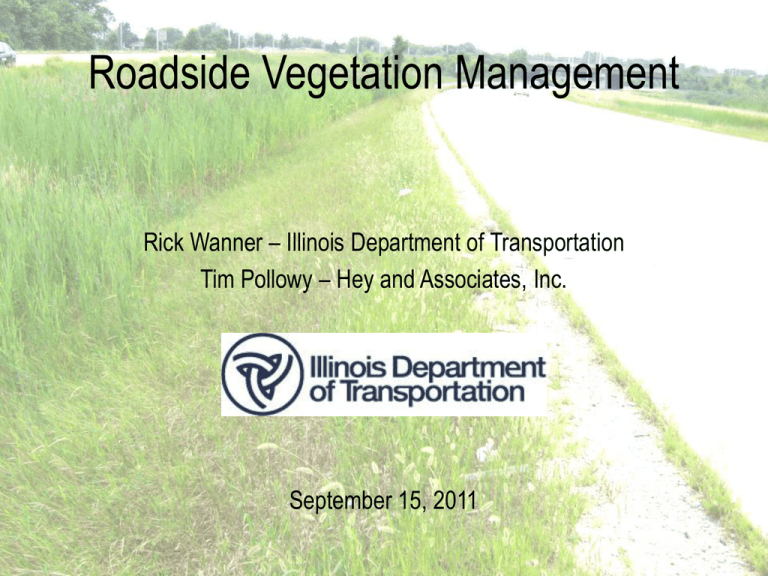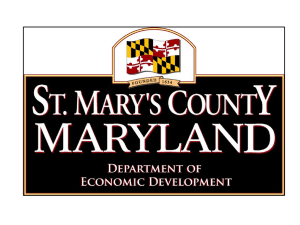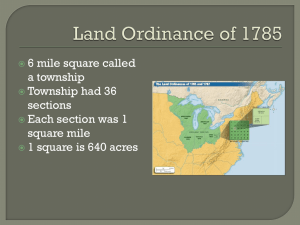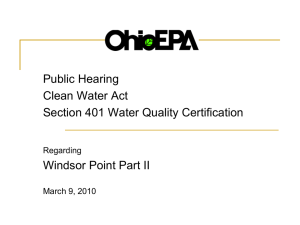Rick Wanner, IDOT District 1, and Tim Pollowy, Hey & Associates
advertisement

Roadside Vegetation Management Rick Wanner – Illinois Department of Transportation Tim Pollowy – Hey and Associates, Inc. September 15, 2011 A little bit of background… • IDOT District 1 includes the six county metro Chicago area • ~2,791 miles of roadway in District 1 that IDOT is responsible for maintaining • Does not include tollroads (which are ISTHA’s responsibility) • Over 3,500 acres of expressway roadsides in District 1 • Over 13,500 acres of primary route roadsides in District 1 History… • In District 1, roadside landscape maintenance was (and in some cases remains) the responsibility of 23 separate IDOT Maintenance Yards spread out over 6 counties. • Abilities vary greatly between the Yards. • As budgets and staff were cut, more and more maintenance work has been contracted out. • Past complications with “No Spray” Maps Roadside Maintenance… • • • • Vegetation management – Zone 1 vs. Zone 2 Litter Traffic control and safety Coordination: Maintenance Yards vs. Contractors, politics vs. plans Trash along Dan Ryan Expressway Impact attenuator and arrow board behind spray truck Zone 1 • • • • Zone 1 = roadside closest to and directly related to traveled lanes “Mow maps” to define limits of mowing along expressways Reduced mowing (acreage and frequency) Maintain Zone 1 weed free to avoid spreading weeds during mowing Oops! Zone 2 • Zone 2 = roadside beyond Zone 1 • Stronger relationship with adjacent property • TVM (Targeted Vegetation Management) – “Prescriptions” for managing prairie, woodland, landscaped areas, and other cover types Weed control along the Bishop Ford Expressway GIS Mapping & Database • In December of 2009, IDOT retained a consultant team led by Hey and Associates, Inc. to assist District 1 Bureau of Maintenance Operations with wetlands, erosion control, and landscape issues. • In 2010, Hey and Associates began development of GIS mapping and a database for all expressway roadsides while simultaneously managing numerous maintenance contracts including mowing, herbicide application, and urban forestry. Results: I-290 Reconstruction (2010) 2010 Eisenhower Expressway reconstruction • ~60 acres of selective clearing completed • Removal of invasive (e.g. Siberian elm) and hazard trees • Native seed (provided by IDNR) hand broadcasted in Zone 2 areas I-290 near Independence Boulevard (2010) I-290 near Oak Park (2011) Results – Weed Control (2011) • ~ 550 Zone 2 acres sprayed targeting teasel (Dipsacus laciniatus and D. sylvestris) in 2011 via general weed control contract • ~ 80 Zone 1 & 2 acres sprayed targeting common reed (Phragmites australis) in 2011 via general weed control contract Thorndale Avenue @ I-290 (before control) Thorndale Avenue @ I-290 (after control) Results: I-80 Widening/Resurfacing (2011) 2011 I-80 resurfacing and lane widening • ~18 acres of selective clearing completed, 4 ½ more acres planned • ~ 7 acres of teasel control completed, more planned this Fall • ~ 10 acres of common reed control completed Larkin Avenue @ I-80 (before control) Larkin Avenue @ I-80 (after control) Looking ahead… • Limited resources • Prioritize maintenance activities and locations • Three goals… Sauk Trail @ I-57 (SW infield) Goal #1: Maintain Nice Areas • Continue to maintain Zone 1 • Identify areas of higher quality vegetation within IDOT ROW • Manage these areas to prevent degradation Sauk Trail @ I-57 (SW infield) Manheim Road @ I-290 (SE infield) Goal #2: Target New Invaders • Identified and targeted: Johnson grass, Leafy spurge, Blue globe thistle, and Oriental bittersweet Goal #3: Coordination • IDOT seeks to coordinate invasive species control with adjacent land owners/managers • Weed control “on both sides of the fence” • Keep invasive species out of high quality natural areas • IDOT policy requires coordination with IDNR Heritage Biologist prior to any herbicide use adjacent to Nature Preserves and INAI sites







